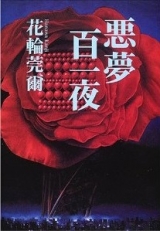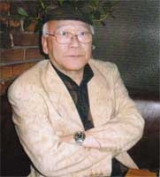2014/04/25 |
Visions Bring Art to Life |
|---|


The offices of literary agents are always inundated with books of all genres. One title that really stands out amidst the mountains of books at Japanese Writers’ House is Akumu Hyaku Ichiya (One Hundred and One Nightmares, published by Uchiyama), a collection of short stories by Kanji Hanawa, the professor emeritus of French literature at Kokugakuin University.
When I first came across this work, I balked. It’s an enormous tome, totaling 1,338 pages in two volumes - a real doorstopper! Once I started reading it, however, I found myself enthralled and was hooked in no time. The characters are caught up in tragic imbroglios woven with a blend of humor and fear, drawing readers into a strange world where reality and fantasy commingle. This extraordinary collection of spine-chillers and tales of the unexpected is a true work of literature.
Recalling the joy of reading one of these stories each day, I used to carry it around with me to read on the train during my commute. However, my bag looked for all the world like an anaconda that had just swallowed a sheep, and on top of that I couldn’t fit in any of the other papers I needed for work, so after giving it much careful thought, I tried switching my reading space from the commuter train to the bath. Savoring the heightened effect of the stories and their visionary world with the lights off, enveloped in a dim candlelit haze, I was even further captivated. Kanji Hanawa’s works often strike me as comparable to the appeal of the “Alfred Hitchcock Presents” series, but just who is this author so infinitely capable of stimulating our subconscious and sense of dread?
Mr. Hanawa has twice been shortlisted for the Akutagawa Prize. I was nervous that he might be rather difficult, but upon meeting him I was relieved to find that he is in fact very sociable. He talked about his creative activity, his devotion to researching French fin de siècle literature, particularly Arthur Rimbaud, and his translation of Rimbaud’s Complete Works in which he attempts to convey their lucidity, humor, and occasional decorous eroticism in language worthy of a French scholar.
Themes in his stories range from historical characters to common people, from politics to ghost stories, passing through a staggering number of topics encompassing the whole of creation. I once ventured to ask him just how he managed to write so many stories like these.
“I’m fascinated by things that are intriguing. I also find dreams quite compelling. When I was young I read Hayao Kawai’s Myôe yume o ikiru (The Buddhist Priest Myôe: A Life of Dreams) with great interest, and ever since then, for over thirty years, I have been keeping a dream diary. I believe that writers are artists precisely because they have a vision that ordinary people lack and are able to express what they see. In France, the visionnaire is highly appreciated. Politicians often use the word “vision,” but they are mistaken: “project” would probably better describe what they mean. The word visionnaire indicates seeing a world on another dimension. It’s the sort of world that can be seen even in, for example, The Tale of Genji. When an author does not just simply write down what he sees happening around him but reveals ghosts or messages from the gods, stories become not just tremendously interesting but also thoroughly engrossing. The appeal is different to that of an authoritative ancient text. In terms of entertainment, I like rakugo (traditional comic story telling), and in the postwar period when there were few diversions I used to be glued to the radio listing to rakugo. You’ve noticed that there is always a twist in my stories? That’s from rakugo, you know.”
With his view of postwar Japan as well as his unique talent and perspective, Mr. Hanawa clearly draws a line under the style of the traditional Japanese genre of the I-Novel. It is fair to say that he has been largely ignored by the literary world. I imagine that the “Damned Poet” Arthur Rimbaud, who Mr. Hanawa has held in high esteem ever since his youth, also probably felt a sense of alienation - but even if he was rather inept he was utterly sincere. He radically changed French literature, and remains a genius among all the talents still read today worldwide. Mr. Hanawa, for his part, is an author eminently capable of crossing borders and captivating readers worldwide. It is extremely gratifying to picture people the world over lugging around a bag bulging with his book!
(Koji Chikatani, Senior Agent, Japanese Writers' House)
♠ Check out Hanawa's Compos Mentis on WORDS without BODERS.
Kanji Hanawa
Novelist, Translator, and Professor Emeritus of Kokugakuin University, Tokyo
Born 6 January 1936 in Tokyo
BA in French Literature from Tokyo University in 1960
PhD from Tokyo University in 1965
Specialist in fin-de-siecle French literature, with particular focus on Arthur Rimbaud
«Novels»
1971 Jûmen no matsuri
(Festival of Scowls) shortlisted for the Akutagawa Prize
Furerareta yami (Touched by Darkness) shortlisted for the Akutagawa Prize
1972 Garasu no natsu (Summer of Glass)
1975 Uzumoreta toki (Time Buried by War)
1996 Selections from his earlier short story collection Akumu [meiga] gekijô (Theater of [Famous] Nightmares, Vol. 2, 1982) published in pocket book form as Akumu shogekijô (Small Theater of Nightmares) and Umi ga nomu(The Swallowing Ocean; vol. 2 of Small Theater of Nightmares). These were later published in a single volume as Akumu gojûichi ya (Fifty-one Nightmares) in 1999, to which a further fifty stories were added to make Akumu hyakuichi ya (Hundred and One Nightmares) in 2006.
«Critical Biography»
1987 Sakamoto Ryôma to sono
jidai (Sakamoto Ryoma and Those Times)
Biography of the beloved champion of the Meiji Restoration dubbed the
“democratic samurai.”
1988 Ishiwara Kanji dokuso su
(Kanji Ishiwara, the Lone Runner)
Biography of the “brains of the army” who, as chief of staff, opposed both the
war with China and the war with America.
«Essay»
1989 Neko kagami (The Looking-Glass Cat), a folkloric study lamenting the decline of the so-called Japanese cat, republished in a 2002 pocket book edition entitled Neko wa hontô ni bakeru no ka (Are Cats Really Shapeshifters?).
1997 Neko gaku nyûmon (An Introduction to Cats), expanding on the earlier work.
«Translation»
* a selection of his many published translations of French literature
1969 Kaitei niman kairi (Vingt Mille Lieues Sous Les Mers) by Jules Verne
1970 Kinjirareta asobi (Les Jeux Interdits), by Francois Boyer
1976 - 77 Ranbô zenzhû (Complete Works of Rimbaud), 2 vols., including the first ever translation into Japanese of “Album Zutique,” together with commentary.
